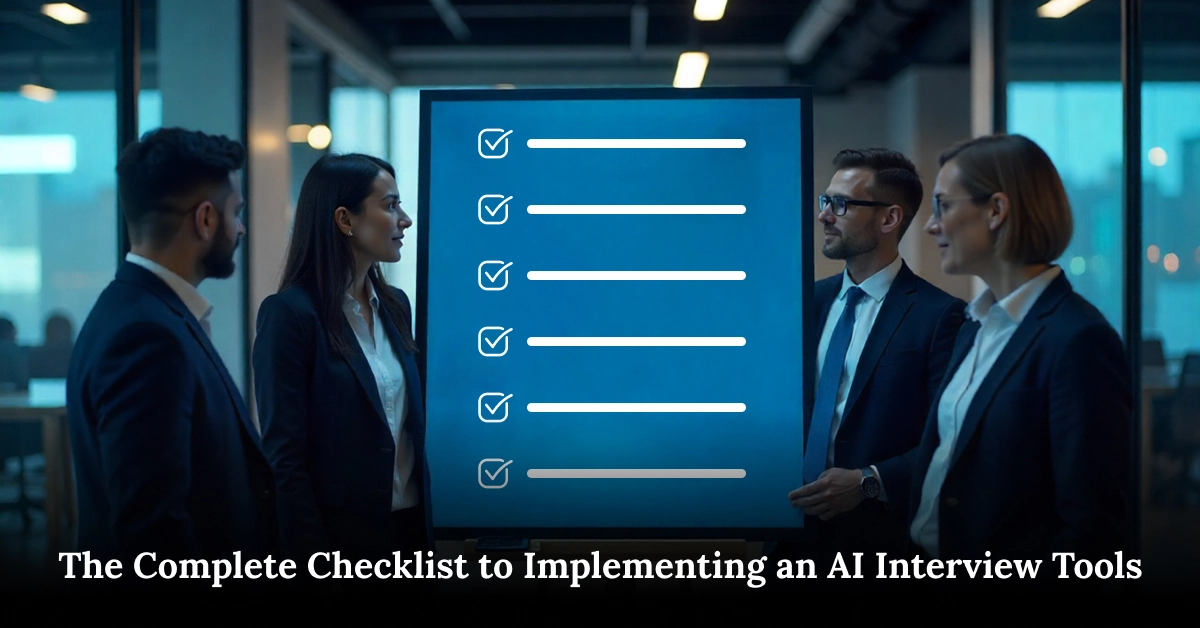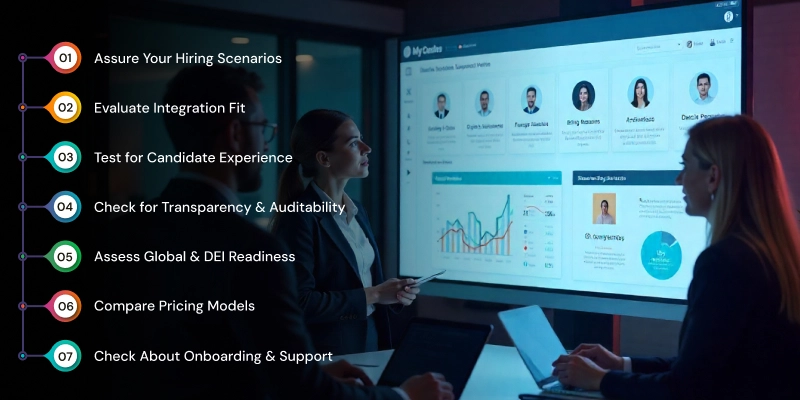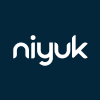The Complete Checklist to Implementing an AI Interview Tools

There are over 60% companies leveraging AI implementation in recruitment and hiring processes this year. A major shift has taken place from manual to AI interview platform. Many AI Interview tools are making life easy for HR recruiters. HR tech integration connects your AI hiring tools smoothly with current running systems.
Direct switchover to AI without any set groundwork and structure will create a mess. A pilot test offers you a chance to check the tool’s impact and customize it to your organization’s culture and technology landscape.
Niyuk is the most trending AI interview platform available today. Setting up interview automation simplifies your initial screening processes.
Niyuk offers a smarter way to handle initial job interviews, saving recruiters a lot of time – 60-70% less effort in those earlier stages. It delivers the same and fair experience to each candidate, raising the same questions and their objective assessment.
This means you may search the right people, suitable for the job without trusting on manual screening only. Actually, Niyuk frees up your team from all repetitive tasks, making them focus on building, developing real connections and creating intelligent hiring choices.
In this blog article, we provide a 10-point beginner’s complete checklist, a simplified roadmap for HR leaders to pilot their first AI hiring tool with assurance.
This approach guarantees that you achieve quantifiable outcomes, leadership trust, and momentum for full-scale implementation, from setting SMART goals to iterating based on actual feedback. An interview automation checklist directs a perfect success roadmap.
Transform Your Hiring Process
Leverage an advanced AI Interview Platform to find your perfect candidate easily
Step 1: Outline Plain Objectives
Action Plan: find 2–3 SMART goals, like reducing screening time with 30%, boosting recruiter satisfaction scores with 20%, or raising candidate diversification feature by 15%.
Incorporating goals like Specific, Measurable, Achievable, Relevant, and Time‑bound (SMART) take along internal teams and set ups a certain checking structure.
Importance: objectives direct vendor selection, pilot(trial) scope, with KPI tracking. Without them, it’s tough to prove value-to-scale.
Step 2: Secure Executive & HR Buy-In
Action plan: give a reworked pilot(trial) proposal to main users, CHRO, CFO, IT, and Legal with distinct KPIs, timelines, and risk catering plans (e.g., data privacy and ROI vision). Facilitate single page summary highlighting expected benefits and budget requisites.
Importance: Executive sponsorship assures that you have the required support budget, way to systems, and executive oversight vital for pilot success.
Step 3: Assemble Your Pilot Team
Action plan: Compose a cross-functional steering group with:
- HR managers and recruiters
- Talent acquisition specialists
- IT or systems integrator
- Data/privacy officer (for GDPR/CCPA compliance)
- An HR “AI champion” to lead adoption
Importance: This balanced team mixes recruitment needs, technical possibility, compliance oversight, and internal advocacy, making sure a seamless pilot journey.
Experience unbiased, efficient candidate screening with our intelligent AI Interviewer
Get Your New AI Interview Platform
Step 4: Select Use Cases & Roles
Action plan: Select 1–2 use cases like high-volume customer service roles or early-career technical positions, as your pilot entrusts.
Importance: A stiff scope helps isolate variables, streamline workflows, and produce rapid learning. Start with non‑executive roles to lessen risk.
A focused pilot skips complications, come from trying to implement across 50 roles from the very first day.
Step 5: Define Success Metrics
Action plan: Select KPIs, such as the applicant drop-off rate, the time to screen drop off, the net promoter score (NPS) from recruiters, and the relationship between AI scores and recruiter checks.
Both quantitative and qualitative data, such as recruiter comments, should be included in your pilot dashboard.
Importance: Predefined KPIs support you to judge pilot success objectively and set on scalability.
Step 6: Prepare Your Data & Integration
Action plan: Clean candidate data for consistency and set integration channels via your ATS or other HR systems. Make consent for capture and data retention matching with GDPR/CCPA. Run a small test import of trial data to verify the syncing flow and field mapping.
Importance: Seamless, secure data integration avoids errors, safeguards candidate privacy, and retains operational continuity.
A key mistake to avoid skipping rough(trial) data testing. You’ll discover mismatches soon, like mis formatted dates or incompatible scoring fields, saving hours of repairing later.
Step 7: Configure & Customize the AI Tool
Action plan: Upload your competency framework into the tool. Set up async interview questions (video, avatar, or chatbot style) and declare structured scoring headings with thresholds. Use vendor templates as an initial point but customize them to reflect your company’s culture and role expectations.
Importance: Out-of-the-box templates hardly fit all. Customising ensures that every element aligns with your hiring requirements and brand identity, from language to score logic.
Pro Tip: You can compare performance and candidate feedback with pilot having two interview sets, one exact vendor variant and one tailored variant.
Step 8: Train Users & Communicate
Action plan: Schedule a half-day meeting for hiring managers, recruiters. Get along with live walkthroughs, role-play reply to reviews, and Q & A. Share quick reference materials and record a voice-over of 10 minutes “how-to” demo.
Importance: Familiarity is the catalyst for adoption. HR teams mainly prefer to use this tool, give exceptional or outstanding feedback, and depends on AI-driven insights upon it’s use.
Step 9: Launch Pilot & Monitor Closely
Action plan: Go live with pilot roles. Monitor key metrics, completion rates, average reply length, and candidate drop-offs on daily or weekly basis. Deploy a standing 30-minute check-in to review dashboard fluctuations and qualitative feedback of candidate.
Importance: Early alerts correct or restrict your increasing mistakes. Missed queries? Twist the instructions. Low completion? Adjust alerts or question count.
Real-time visibility keeps process on and assures for a smooth rollout.
Step 10: Collect Feedback & Iterate
Action plan: At the pilot end, survey recruiters and candidates using brief NPS questions (e.g., “Would you refer this experience?”). Connect surveys with AI data review, looking at confidence scores, declining patterns, or flagged bias trends.
Utilise a shared feedback log (e.g., a Google Sheet) for issues tracking and assign actions. Emphasis on small but high-impact changes, like rephrasing a question, shortening video prompts, or adjusting headlines weights.
Then, try testing updates with a second mini‑pilot group.
Importance: This journey makes sure that your final setup reflects real user requirements, improving adoption and delivering good candidate experiences.
Select the Right AI Interview Tool for Your Hiring Stack
Selecting the right AI interviewer tool is not just a technical decision, it’s all about a strategic recruitment investment. The best platform must match with your hiring volume, team workflow, and candidate expectations.
Here’s a practical, stepwise guide to support you to choose smart AI interview tool:

1. Assure Your Hiring Scenarios
Begin with identifying your actual recruitment needs:
- High-volume campus hiring?
- Unique technical roles?
- Multilingual customer support?
- Executive leadership?
Your use case decides which features are critical vs. optional. If you’re bulk hiring, then automation, scoring, and analytics are important. For leadership roles hiring, custom flows and open-ended NLU are important.
2. Evaluate Integration Fit
Ask:
- Does it sync into your existing ATS or HRIS?
- Can it auto-schedule using your team calendars?
- Can you start it from your existing hiring tools?
- The goal: zero repeat effort and no new storages.
3. Test for Candidate Experience
Start a test interview as if you’re a candidate:
- Is the interface clean & mobile-friendly?
- Does the AI interviewer feel robotic or human-like?
- Are all instructions clear, accessible, and non-technical?
- A great AI tool enhances your employer brand, not harms it.
4. Check for Transparency & Auditability
Skip black-box AI. You must be able to:
- See how scores were generated
- Adjust scoring logic per job role
- Access bias-handling settings
- Generate reports for compliance review
- If it’s not explainable, it’s not trustworthy.
5. Assess Global & DEI Readiness
- Is it capable of managing a variety of languages, accents, and regional variations?
- Does it treat all candidates fairly?
- Are there built-in checks for- age, gender, or accent bias?
This is tough, if you’re scaling hiring across geographies or want to get DEI goals.
6. Compare Pricing Models
- Is pricing depending on interviews, users, or hires?
- Are core features behind paywalls?
- Pricing they give is per-department or agency pricing?
- Check out that the features usefulness, which you are paying for rather than just an additional baggage.
7. Check About Onboarding & Support
- Do they offer onboarding for your team?
- Is customer support ticket-based or live?
- Can they help you optimizing question flows?
Tools are only as best as your team’s ability to use them.
The best AI interviewer tool isn’t the costlier, it’s the one that fits your hiring style, integrates cleanly, giving you control, and improves on time.
Utilize the leading AI Interview Platform for smarter, faster, and fair hiring outcomes
Embrace your recruitment Journey with us
Conclusion
Setting up your very first AI interview tools doesn’t have to be a huge headache. Just carry out a straightforward path, maybe like a checklist like given above, and you will easily tap into the real power of bringing AI into your hiring process. This kind of managed approach, initiating with clear goals and managing the things as you get feedback, supports you collect genuine insights and develop confidence inside your team. If you handle this starting phase well, it really sets the stage for using AI hiring software across your entire company.
What you will see are fast ways to screen candidates, fair assessments for all, and a much better experience for job aspirants. This all adds up to a solid return on your investment over time, truly transforming how you find and bring in new talent. A big part of making this work seamlessly involves getting all, comfortable with the AI tool onboarding and making sure that it plays nicely with your existing HR technology integration.
Exactly here, something like Niyuk.ai’s AI interviewer comes in handy. Their AI interview platform offers exactly what you required to make this shift, taking to fair and efficient candidate checks.
For more clarification and details, mail Niyuk team on: info@niyuk.ai
We are highly obliged to serve every business query with no time.
Frequently Asked Questions
1. What is an AI Interview Tool?
AI Interview Tool is crafted to simplify the starting phase of screening candidates, mostly identifying individuals who are best matching with a certain role. This tool focus to remarkably reduce the time spent in the initial stages of interviews, mainly by 60% to 70%. It works to make sure that a consistent and fairer interview experience for all applicants while declining the dependency on recruiters for repetitive tasks in screening.
2. What key features should I look for in an AI interview tool?
- Bias Mitigation Algorithms
- Voice & Video Interview Capability with AI Analysis
- AI-Driven Candidate Scoring & Benchmarking
- Natural Language Understanding (NLU)
- Customizable Interview Flows & Question Generation
- ATS & Calendar Integration
- Comprehensive Analytics & Reporting
- Scalability & Consistency
- Candidate Experience Focus
- Data Security & Compliance
- Proctoring & Cheating Prevention (if applicable)
3. Are AI interview tools biased?
AI interview tools can be biased if not carefully designed, trained, and monitored, but they also have the potential to reduce human bias. But with Niyuk can be rest assured, as all these issues have been taken care while designing Niyuk AI solutions.
4. Will AI interview tools replace human recruiters?
No, AI interview tools are highly unlikely to entirely replace human recruiters. But on the other side, it will simplify many tasks of the human recruiters during hiring process as well as will save time and money for the process.
